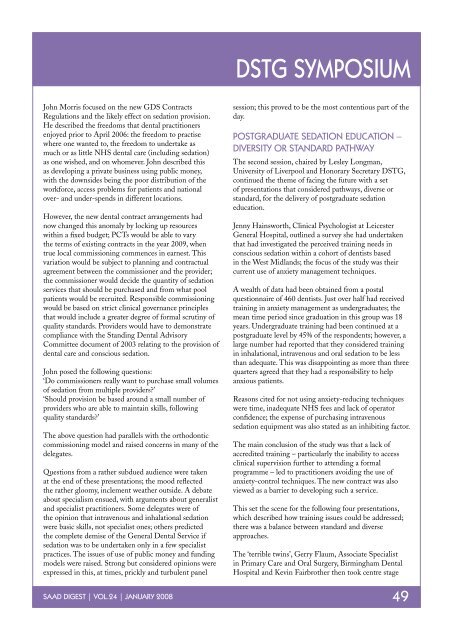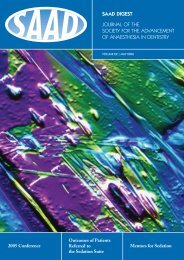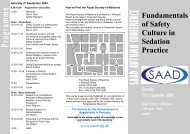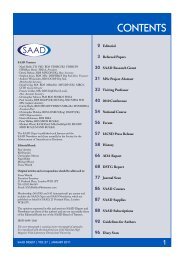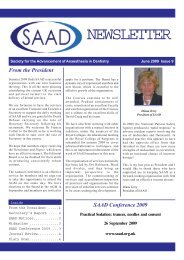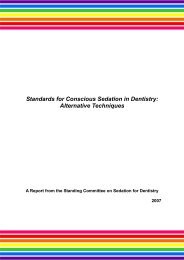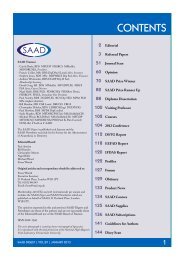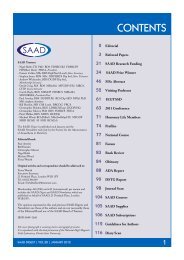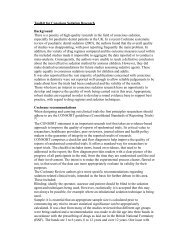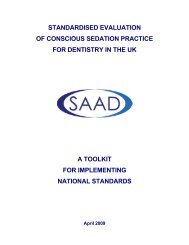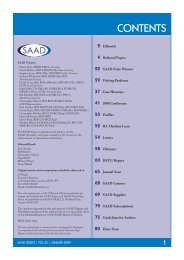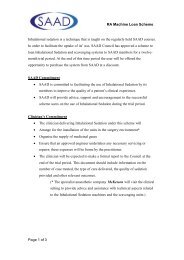Volume 24 - The Society for the Advancement of Anaesthesia in ...
Volume 24 - The Society for the Advancement of Anaesthesia in ...
Volume 24 - The Society for the Advancement of Anaesthesia in ...
You also want an ePaper? Increase the reach of your titles
YUMPU automatically turns print PDFs into web optimized ePapers that Google loves.
DSTG SYMPOSIUM<br />
John Morris focused on <strong>the</strong> new GDS Contracts<br />
Regulations and <strong>the</strong> likely effect on sedation provision.<br />
He described <strong>the</strong> freedoms that dental practitioners<br />
enjoyed prior to April 2006: <strong>the</strong> freedom to practise<br />
where one wanted to, <strong>the</strong> freedom to undertake as<br />
much or as little NHS dental care (<strong>in</strong>clud<strong>in</strong>g sedation)<br />
as one wished, and on whomever. John described this<br />
as develop<strong>in</strong>g a private bus<strong>in</strong>ess us<strong>in</strong>g public money,<br />
with <strong>the</strong> downsides be<strong>in</strong>g <strong>the</strong> poor distribution <strong>of</strong> <strong>the</strong><br />
work<strong>for</strong>ce, access problems <strong>for</strong> patients and national<br />
over- and under-spends <strong>in</strong> different locations.<br />
However, <strong>the</strong> new dental contract arrangements had<br />
now changed this anomaly by lock<strong>in</strong>g up resources<br />
with<strong>in</strong> a fixed budget; PCTs would be able to vary<br />
<strong>the</strong> terms <strong>of</strong> exist<strong>in</strong>g contracts <strong>in</strong> <strong>the</strong> year 2009, when<br />
true local commission<strong>in</strong>g commences <strong>in</strong> earnest. This<br />
variation would be subject to plann<strong>in</strong>g and contractual<br />
agreement between <strong>the</strong> commissioner and <strong>the</strong> provider;<br />
<strong>the</strong> commissioner would decide <strong>the</strong> quantity <strong>of</strong> sedation<br />
services that should be purchased and from what pool<br />
patients would be recruited. Responsible commission<strong>in</strong>g<br />
would be based on strict cl<strong>in</strong>ical governance pr<strong>in</strong>ciples<br />
that would <strong>in</strong>clude a greater degree <strong>of</strong> <strong>for</strong>mal scrut<strong>in</strong>y <strong>of</strong><br />
quality standards. Providers would have to demonstrate<br />
compliance with <strong>the</strong> Stand<strong>in</strong>g Dental Advisory<br />
Committee document <strong>of</strong> 2003 relat<strong>in</strong>g to <strong>the</strong> provision <strong>of</strong><br />
dental care and conscious sedation.<br />
John posed <strong>the</strong> follow<strong>in</strong>g questions:<br />
‘Do commissioners really want to purchase small volumes<br />
<strong>of</strong> sedation from multiple providers?’<br />
‘Should provision be based around a small number <strong>of</strong><br />
providers who are able to ma<strong>in</strong>ta<strong>in</strong> skills, follow<strong>in</strong>g<br />
quality standards?’<br />
<strong>The</strong> above question had parallels with <strong>the</strong> orthodontic<br />
commission<strong>in</strong>g model and raised concerns <strong>in</strong> many <strong>of</strong> <strong>the</strong><br />
delegates.<br />
Questions from a ra<strong>the</strong>r subdued audience were taken<br />
at <strong>the</strong> end <strong>of</strong> <strong>the</strong>se presentations; <strong>the</strong> mood reflected<br />
<strong>the</strong> ra<strong>the</strong>r gloomy, <strong>in</strong>clement wea<strong>the</strong>r outside. A debate<br />
about specialism ensued, with arguments about generalist<br />
and specialist practitioners. Some delegates were <strong>of</strong><br />
<strong>the</strong> op<strong>in</strong>ion that <strong>in</strong>travenous and <strong>in</strong>halational sedation<br />
were basic skills, not specialist ones; o<strong>the</strong>rs predicted<br />
<strong>the</strong> complete demise <strong>of</strong> <strong>the</strong> General Dental Service if<br />
sedation was to be undertaken only <strong>in</strong> a few specialist<br />
practices. <strong>The</strong> issues <strong>of</strong> use <strong>of</strong> public money and fund<strong>in</strong>g<br />
models were raised. Strong but considered op<strong>in</strong>ions were<br />
expressed <strong>in</strong> this, at times, prickly and turbulent panel<br />
session; this proved to be <strong>the</strong> most contentious part <strong>of</strong> <strong>the</strong><br />
day.<br />
Postgraduate Sedation Education –<br />
Diversity or Standard Pathway<br />
<strong>The</strong> second session, chaired by Lesley Longman,<br />
University <strong>of</strong> Liverpool and Honorary Secretary DSTG,<br />
cont<strong>in</strong>ued <strong>the</strong> <strong>the</strong>me <strong>of</strong> fac<strong>in</strong>g <strong>the</strong> future with a set<br />
<strong>of</strong> presentations that considered pathways, diverse or<br />
standard, <strong>for</strong> <strong>the</strong> delivery <strong>of</strong> postgraduate sedation<br />
education.<br />
Jenny Ha<strong>in</strong>sworth, Cl<strong>in</strong>ical Psychologist at Leicester<br />
General Hospital, outl<strong>in</strong>ed a survey she had undertaken<br />
that had <strong>in</strong>vestigated <strong>the</strong> perceived tra<strong>in</strong><strong>in</strong>g needs <strong>in</strong><br />
conscious sedation with<strong>in</strong> a cohort <strong>of</strong> dentists based<br />
<strong>in</strong> <strong>the</strong> West Midlands; <strong>the</strong> focus <strong>of</strong> <strong>the</strong> study was <strong>the</strong>ir<br />
current use <strong>of</strong> anxiety management techniques.<br />
A wealth <strong>of</strong> data had been obta<strong>in</strong>ed from a postal<br />
questionnaire <strong>of</strong> 460 dentists. Just over half had received<br />
tra<strong>in</strong><strong>in</strong>g <strong>in</strong> anxiety management as undergraduates; <strong>the</strong><br />
mean time period s<strong>in</strong>ce graduation <strong>in</strong> this group was 18<br />
years. Undergraduate tra<strong>in</strong><strong>in</strong>g had been cont<strong>in</strong>ued at a<br />
postgraduate level by 45% <strong>of</strong> <strong>the</strong> respondents; however, a<br />
large number had reported that <strong>the</strong>y considered tra<strong>in</strong><strong>in</strong>g<br />
<strong>in</strong> <strong>in</strong>halational, <strong>in</strong>travenous and oral sedation to be less<br />
than adequate. This was disappo<strong>in</strong>t<strong>in</strong>g as more than three<br />
quarters agreed that <strong>the</strong>y had a responsibility to help<br />
anxious patients.<br />
Reasons cited <strong>for</strong> not us<strong>in</strong>g anxiety-reduc<strong>in</strong>g techniques<br />
were time, <strong>in</strong>adequate NHS fees and lack <strong>of</strong> operator<br />
confidence; <strong>the</strong> expense <strong>of</strong> purchas<strong>in</strong>g <strong>in</strong>travenous<br />
sedation equipment was also stated as an <strong>in</strong>hibit<strong>in</strong>g factor.<br />
<strong>The</strong> ma<strong>in</strong> conclusion <strong>of</strong> <strong>the</strong> study was that a lack <strong>of</strong><br />
accredited tra<strong>in</strong><strong>in</strong>g – particularly <strong>the</strong> <strong>in</strong>ability to access<br />
cl<strong>in</strong>ical supervision fur<strong>the</strong>r to attend<strong>in</strong>g a <strong>for</strong>mal<br />
programme – led to practitioners avoid<strong>in</strong>g <strong>the</strong> use <strong>of</strong><br />
anxiety-control techniques. <strong>The</strong> new contract was also<br />
viewed as a barrier to develop<strong>in</strong>g such a service.<br />
This set <strong>the</strong> scene <strong>for</strong> <strong>the</strong> follow<strong>in</strong>g four presentations,<br />
which described how tra<strong>in</strong><strong>in</strong>g issues could be addressed;<br />
<strong>the</strong>re was a balance between standard and diverse<br />
approaches.<br />
<strong>The</strong> ‘terrible tw<strong>in</strong>s’, Gerry Flaum, Associate Specialist<br />
<strong>in</strong> Primary Care and Oral Surgery, Birm<strong>in</strong>gham Dental<br />
Hospital and Kev<strong>in</strong> Fairbro<strong>the</strong>r <strong>the</strong>n took centre stage<br />
SAAD DIGEST | VOL.<strong>24</strong> | JANUARY 2008 49


